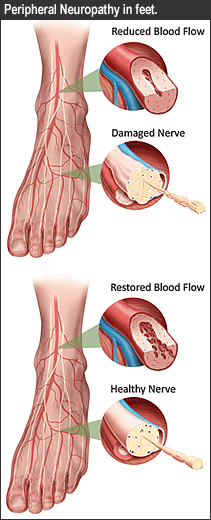Elevated
Triglyceride Level Increases Likelihood of Peripheral Neuropathy
 |
 |
 |
 |
 |
 |
 |
| SUMMARY:
HIV positive people with higher blood triglyceride
levels are more likely to develop peripheral sensory
neuropathy, or nerve damage, according to a study
described in the January
14, 2011 issue of AIDS. Investigators
suggested that the relationship might be due to
changes in mitochondria function associated with
elevated triglycerides. |
|
 |
 |
 |
 |
 |
 |
 |
By
Liz Highleyman
 Peripheral
neuropathy, usually affecting the feet, is common among people
with HIV. This is still the case even though the antiretroviral
drugs most strongly associated with nerve damage -- the
"d-drugs" stavudine
(d4T, Zerit), didanosine
(ddI, Videx), and zalcitabine (ddC, Hivid; withdrawn from
the market in 2005) -- are no longer widely used in the U.S.
Peripheral
neuropathy, usually affecting the feet, is common among people
with HIV. This is still the case even though the antiretroviral
drugs most strongly associated with nerve damage -- the
"d-drugs" stavudine
(d4T, Zerit), didanosine
(ddI, Videx), and zalcitabine (ddC, Hivid; withdrawn from
the market in 2005) -- are no longer widely used in the U.S.
Noting
that elevated serum triglyceride levels and other metabolic
abnormalities are associated with an increased risk for
sensory neuropathy among people with diabetes, Sugato Banerjee
from the HIV Neurobehavioral Research Center at the University
of California at San Diego and colleagues designed a prospective
cross-sectional cohort study to evaluate whether a similar
link is evident in people with HIV.
The investigators looked at predictors of sensory neuropathy
in HIV positive and HIV negative individuals. The study included
436 people with HIV; most were men, the median age was 52
years, and 75% were on combination antiretroviral therapy
(ART). In addition, 55 HIV negative people served as control
subjects.
HIV sensory neuropathy was defined as having 1 or more clinical
signs of reduced distal sensation or ankle reflexes. Symptoms
included leg and foot pain, parasthesias (tingling or other
unusual sensations), and numbness.
The researchers assessed metabolic factors including triglyceride
levels, other blood lipids, and glucose levels, as well as
other neuropathy risk factors such as age, height, current
and nadir (lowest-ever) CD4 T-cell count, and current or past
use of protease inhibitors, "d-drugs," and cholesterol-lowering
statins.
Results
 |
27%
of the HIV positive participants had sensory neuropathy,
compared with 10% of the HIV negative group. |
 |
48%
of the HIV positive people with neuropathy were symptomatic,
while the rest had measurable clinical signs. |
 |
Overall,
average triglyceride levels were significantly higher
among HIV positive compared with HIV negative participants
(mean 245 vs 160 mg/dL, respectively; P < 0.001). |
 |
After
adjusting for other factors, HIV positive patients with
triglyceride levels in the highest tertile, or third (244
mg/dL or less), were significantly more likely to have
sensory neuropathy than those in the lowest tertile (142
mg/dL or less), with an adjusted odds ratio of 2.7, or
nearly 3 times higher risk. |
 |
Other
factors associated with neuropathy were older age, greater
height, type 2 diabetes, lower nadir CD4 cell count, and
use of statins. |
 |
Protease
inhibitor use was associated with greater likelihood of
peripheral neuropathy, but unexpectedly, prior use of
the "d-drugs" was not. |
Based
on these findings, the study authors concluded, "Elevated
triglyceride levels increased the risk for HIV sensory neuropathy
in HIV positive individuals independently of other known risk
factors."
In their discussion, they suggested that elevated triglycerides
might have an adverse effect on mitochondria, the energy-producing
structures in cells. Mitochondrial toxicity has been identified
as a mechanism responsible for peripheral neuropathy associated
with the "d-drugs."
Since this study identified elevated triglycerides as a major
risk for peripheral neuropathy in people with HIV, the researchers
recommended that "interventions leading to reduction
of triglyceride levels could reduce incidence of HIV sensory
neuropathy, a possibility that should be explored in future
studies."
Investigator affiliation: Department of Neurosciences,
Department of Medicine, University of California, San Diego,
CA.
1/11/11
Reference
S Banerjee, JA McCutchan BM Ances, and others. Hypertriglyceridemia
in combination antiretroviral-treated HIV-positive individuals:
potential impact on HIV sensory polyneuropathy. AIDS
25(2): F1-6 (Abstract).
January 14, 2011.
